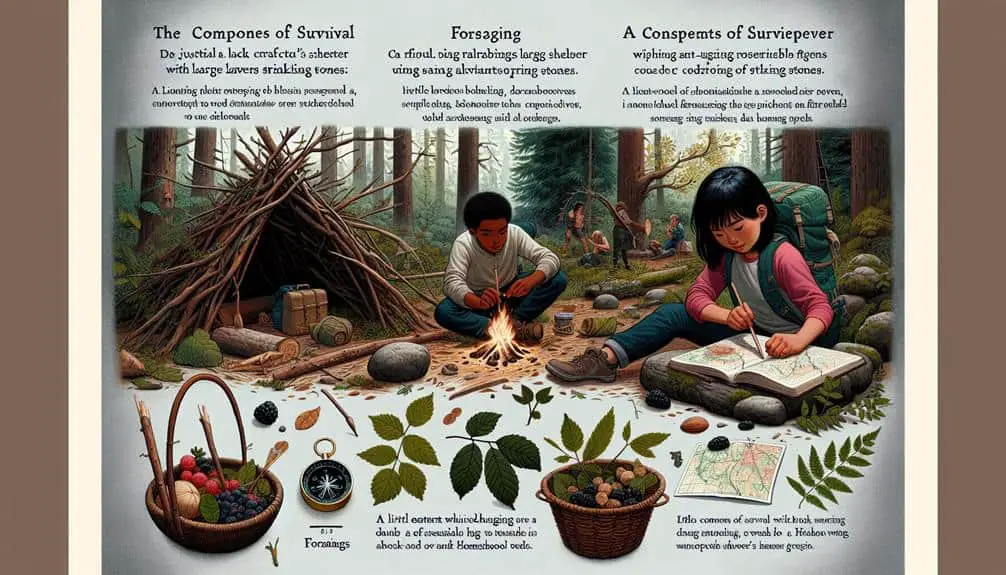Master 7 essential wilderness survival skills for homeschoolers. Build shelters in safe spots with natural materials for insulation. Know how to start fires quickly using tools like matches or a fire starter. Purify water by boiling or filtering it in DIY ways. Learn to identify safe wild edible plants and map reading for navigation. Get skilled in basic first aid, including wound care and CPR. Sharpen your awareness of nature with sensory training. These skills are important for outdoor adventures, giving you the confidence to handle challenges efficiently.
Key Points
- Shelter building with natural resources for insulation and protection.
- Master fire starting techniques with essential tools.
- Purify water using boiling, filtration, and chemical options.
- Identify safe wild edible plants with expert guidance.
- Develop navigation skills and basic first aid knowledge.
Shelter Building
To build a sturdy shelter in the wilderness, start by selecting a suitable location with ample natural resources for construction. When considering shelter materials, think about using branches, leaves, and any available debris for your survival shelters. These can provide excellent insulation against the elements. Guarantee your emergency shelters are well-insulated to retain body heat, especially in colder climates.
For survival shelters, it's important to choose a spot that isn't prone to flooding and has natural barriers against wind. Look for overhanging branches or rock formations that can offer additional protection. If you have a tarp or emergency blanket, these can be great additions to your shelter to enhance insulation further.
Additionally, consider the size of your shelter – it should be large enough to accommodate you comfortably, but not so big that it's challenging to heat with your body heat alone.
Fire Starting
To successfully start a fire in the wilderness, you need to have essential tools like a fire starter or matches.
Techniques for fire starting include creating a tinder bundle, using dry kindling, and properly arranging your fire lay.
Mastering these skills will guarantee you can quickly and efficiently start a fire in any survival situation.
Essential Fire-Making Tools
How can you efficiently ignite a fire in the wilderness using essential tools?
When it comes to fire-making tools, having a variety at your disposal can be vital for survival. Flint and steel are reliable options, creating sparks when struck together, igniting dry tinder.
Friction fire methods like the bow drill or hand drill require practice but can be effective once mastered. Another tool to take into account is the solar fire starter, which uses sunlight to focus heat onto tinder, starting a fire.
Additionally, a fire piston is a compact tool that uses rapid compression to ignite a small piece of tinder.
Each of these tools has its strengths and can be useful in different situations. Flint and steel are dependable in various weather conditions, while friction fire methods require more effort but can work without relying on external tools.
Solar fire starters are excellent for sunny days, and fire pistons are compact and efficient for those looking for a portable option.
Techniques for Fire Starting
When starting a fire in the wilderness, mastering various techniques is key to guaranteeing your survival. Two traditional methods for creating fire are friction fire using a bow drill and sparking with flint and steel.
The bow drill method involves rotating a wooden spindle against a fire board with a notch, generating heat through friction until an ember forms. This ember is then transferred to a tinder bundle, carefully nurtured into flames.
Flint and steel, on the other hand, involve striking a piece of flint against a steel striker to create sparks that ignite char cloth or a similar material. Another advanced technique is using a fire piston, which compresses air rapidly to ignite a small piece of tinder.
When attempting these methods, patience and practice are essential. Guarantee your materials are dry and suitable for creating fire.
Water Purification
When in the wilderness, ensuring you have access to clean water is essential.
To purify water effectively, consider using the boiling method, filtration techniques, or chemical purification options.
These methods will help you stay hydrated and healthy during your outdoor adventures.
Boiling Water Method
To purify water using the boiling method, begin by filling a pot with water from a clean source and placing it over a heat source until it reaches a rolling boil. This method is an important skill for outdoor cooking and emergency hydration in the wilderness.
Once the water is boiling vigorously, let it continue to do so for at least one minute to make sure harmful bacteria, viruses, and parasites are killed off effectively.
After boiling, allow the water to cool before transferring it to a clean container. Remember, boiling water doesn't remove sediment or chemicals, so it's important to filter it through a cloth or paper towel if these contaminants are present.
When using the boiling water method, ensure you have a heat source and a pot or container that can withstand high temperatures. This technique is reliable, straightforward, and one of the most efficient ways to make water safe for drinking in the wild. Mastering this skill can be a lifesaver in emergency situations.
Filtration Techniques
When considering water purification in the wilderness, filtration techniques are essential for removing impurities and making water safe to drink. In a survival situation, having access to clean water is vital for your well-being.
Here are some DIY filtration techniques you can use with items commonly found in your emergency supply:
- DIY Charcoal Filter: Create a charcoal filter using charcoal from your campfire. Simply layer the charcoal pieces in a container and pour the water through it to trap impurities.
- Improvised Sand Filter: Utilize a makeshift sand filter by creating layers of sand, gravel, and cloth in a bottle or other container. Pour the water through the layers to remove larger particles.
- Boiling and Cloth Filtration: Boil the water to kill harmful bacteria and then use a cloth to filter out any remaining debris. This method is effective in combination for clearer water.
These simple filtration techniques can greatly improve the quality of water you find in the wild, ensuring you stay hydrated and healthy during your wilderness adventures.
Chemical Purification Options
For effective water purification in the wilderness, consider utilizing chemical purification options to guarantee safe drinking water at all times. When venturing outdoors, having a reliable method to purify water is essential for staying hydrated and healthy.
DIY filtration systems are a popular choice, offering a cost-effective way to treat water. However, in situations where filtration isn't feasible, alternative methods such as chemical purification can be a lifesaver.
Chemical purification involves using substances like chlorine dioxide tablets, iodine tablets, or water purification drops to kill harmful bacteria, viruses, and protozoa in the water. These chemicals work by disrupting the microorganisms' cellular functions, rendering them harmless for consumption. It's important to follow the instructions carefully when using chemical purification methods to ensure effective treatment.
When using chemical purification, remember that while it effectively kills most pathogens, it may not remove debris or sediment from the water. Therefore, if possible, combine chemical purification with DIY filtration to improve water clarity and taste.
Wild Edible Plants
You can easily identify wild edible plants by observing their distinct features and knowing where to look. When foraging for wild edibles, it's important to be certain about the plants you intend to consume.
Here are some plant identification and foraging tips to help you safely enjoy the bounty of nature:
- Study Field Guides: Carry reliable field guides specific to your region. These guides often contain detailed descriptions and images of edible plants, making it easier to identify them correctly.
- Consult with Experts: If you're uncertain about a plant, seek guidance from experienced foragers or local botanists. They can provide valuable insights and help you distinguish between edible and toxic plants.
- Start with Easy-to-Identify Plants: Begin by learning about a few easily recognizable wild edibles like dandelions, cattails, or berries. Mastering these plants first can boost your confidence and knowledge before advancing to more challenging species.
To navigate effectively in the wilderness, trust in your ability to read maps and use a compass confidently. Map reading is a fundamental skill; learn to interpret contour lines, identify key landmarks, and understand scale to estimate distances accurately.
Orienteering involves using a map and compass together, aligning the map with the terrain to pinpoint your location and determine your route.
In addition to traditional methods, celestial navigation can be a valuable skill. Look to the stars for guidance; learn to identify Polaris, the North Star, which always points north. Understanding how the position of stars changes throughout the night can help you determine direction even without a compass.
Practice star gazing on clear nights to familiarize yourself with different constellations and their movements.
Basic First Aid
What essential skills should every wilderness explorer possess in regards to basic first aid? When venturing into the great outdoors, being prepared to handle potential medical emergencies is vital. Here are some key skills to help you navigate wilderness medicine and emergency response effectively:
- Prioritize Injury Prevention: Learn how to assess your surroundings to avoid hazards. Preventing injuries is the first step to ensuring your safety in the wilderness.
- Master Wound Care: Understand how to clean and dress wounds properly to prevent infection. Basic wound care skills can make a significant difference in the healing process when medical help isn't readily available.
- Quick Emergency Response: Be prepared to act swiftly in case of an emergency. Knowing how to perform CPR, address shock, and stabilize injuries can be life-saving in critical situations.
Natural Awareness
Developing natural awareness involves sharpening your senses and observation skills to better understand and interact with the environment around you. Sensory training is key to enhancing your ability to perceive subtle changes in your surroundings. Engage in activities that focus on each of your senses individually, like closing your eyes and listening to the sounds of nature or feeling different textures with your hands.
Outdoor observation is an essential aspect of natural awareness. Practice mindful outdoor observation by taking the time to truly see and understand the plants, animals, and landscapes around you. Notice the patterns in nature, the behavior of wildlife, and the changing seasons.
This mindfulness practice will deepen your nature connection and help you anticipate changes in the environment.
Frequently Asked Questions
How Can Homeschoolers Practice Wilderness Survival Skills Indoors?
To practice wilderness survival skills indoors, indulge in innovative indoor practice. Engage in hands-on activities like crafting makeshift shelter models, foraging through your pantry for survival food, or simulating emergency situations for practical experience.
Are There Virtual Reality Tools Available to Enhance These Skills?
Virtual reality training tools offer interactive simulations that can enhance your wilderness survival skills. These tools provide realistic scenarios where you can practice decision-making, navigation, and other critical skills in a controlled environment.
What Are Some Creative Ways to Incorporate Survival Skills Into Homeschool Curriculum?
When teaching survival skills in homeschool, make it fun and practical. Try nature scavenger hunts or backyard camping for hands-on experience. Learn about wild edibles and emergency preparedness to stay safe and prepared.
Can Children Participate in Wilderness Survival Camps or Programs?
You can definitely have your children participate in wilderness survival camps or programs. These experiences provide valuable outdoor education and teach essential safety skills. Make sure to research reputable programs that prioritize safety and learning.
Check out online forums and social media groups for homeschoolers sharing survival tips. Engage in discussions, ask questions, and learn from experienced members. These communities offer valuable insights and support for honing your wilderness survival skills.



